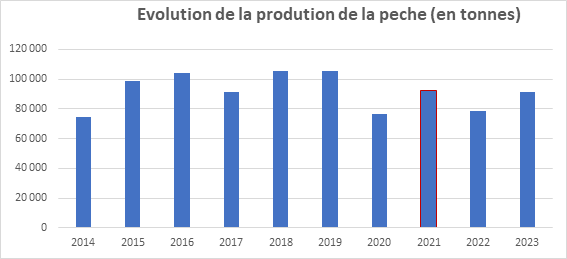Fishing
The Government's vision for fishery production is to develop it and make it competitive in order to reduce dependence on external sources.
Concerned with realizing this ambition, the State has initiated sectoral reforms, including:
the adoption of Law No. 2016-554 of July 26, 2016, relating to fishing and aquaculture,
the establishment of the Satellite Monitoring Center for Fisheries in Abidjan,
the adoption of a national plan to combat Illegal, Unreported, and Unregulated (IUU) fishing in all its forms in waters under national jurisdiction.
In 2022, the Ivorian Government adopted the National Policy for the Development of Livestock, Fishing, and Aquaculture 2022-2026 (PONADEPA 2022-2026). This policy, with an implementation cost estimated at 1,049.443 billion CFA francs, aims to achieve three strategic objectives: (i) improving the productivity and competitiveness of animal and fishery sectors in line with environmental protection principles, (ii) enhancing governance, and (iii) improving the livelihoods of stakeholders.
Specifically, in the fishing sector, the focus is on the sustainable and responsible management of fishery resources, as well as improving the productivity and competitiveness of fishery products.
Regarding aquaculture, the aim is to enhance aquaculture production and develop an aquaculture economy.
The fishing sector represented 0.5% of GDP in 2023 and generates, according to data from the Ministry of Animal and Fishery Resources, nearly 100,000 direct jobs and over 580,000 indirect jobs, one-third of which are held by women. Fishing remains primarily artisanal in Côte d'Ivoire. In 2023, artisanal fishing production accounted for 72% of total fishing production. National production increased from 74,800 tons in 2014 to 91,180 tons in 2023, representing an average annual growth of 2.2% over the period from 2014 to 2023, with a peak of 105,528 tons in 2018.

Source: Ministry of Animal and Fishery Resources/DPSP
In 2020, production recorded a drop of 27.8% due to the impact of measures taken to combat the COVID-19 pandemic.
From 2021 onwards, the erratic developments observed can be explained by fishing practices that do not always comply with standards and compromise species reproduction, water pollution due to gold mining, and piracy that reduces the resources available to local fishermen.
Evolution of National Productions (in tons)
| ITEMS | 2014 | 2015 | 2016 | 2017 | 2018 | 2019 | 2020 | 2021 | 2022 | 2023 |
| Industrial Fishing | 26 180 | 19 211 | 22 476 | 20 997 | 31 212 | 31 996 | 10 434 | 13 689 | 17 303 | 25350 |
| Trawling | 14 356 | 7 899 | 8 417 | 6 688 | 17 645 | 18 709 | 5 741 | 7 185 | 7320 | 7686 |
| Sardine Fishing | 11 824 | 11 312 | 14 059 | 14 309 | 13 567 | 9 897 | 3 610 | 4 513 | 6871 | 7489 |
| Tuna Fishing (Longline) |
|
|
|
|
| 3 390 | 1 083 | 1 991 | 3112 | 2569 |
| Artisanal Fishing | 48 620 | 79 339 | 81 757 | 70 251 | 74 316 | 73 223 | 65 789 | 78 676 | 61 367 | 65830 |
| Maritime | 41 158 | 39 084 | 41 320 | 35 285 | 42 474 | 46 039 | 39 819 | 43 615 | 42220 | 39904 |
| Continental | 7 462 | 40 255 | 40 437 | 34 966 | 31 842 | 27 184 | 25 970 | 35 061 | 36450 | 25926 |
| Total production | 74 800 | 98 550 | 104 233 | 91 248 | 105 528 | 105 219 | 76 223 | 92 365 | 78 670 | 92041 |
Source: Ministry of Animal and Fishery Resources/DPSP
Aquaculture
The general objective of the National Aquaculture Development Strategy (SNDA) is to make aquaculture a high-performing, prosperous sector. Specifically, it aims to contribute to national economic growth, ensure food security, and combat poverty. Ivorian aquaculture has significant development potential. There is considerable room for improvement, not only in terms of exploitable natural potential but also in terms of demand, which is substantial, although it is challenged by imported fish. There are great opportunities for positioning in the markets, provided that producers receive appropriate support to improve the quality of their products and better control the distribution channels and commercial outlets.
| ITEMS | 2019 | 2020 | 2021 | 2022 | 2023 |
| AQUACULTURE | 4500 | 4500 | 6300 | 7056 | 8467 |
Source: Ministry of Animal and Fishery Resources/DPSP
Looking Ahead
the Government plans to continue developing an environmentally friendly industrial and small-scale aquaculture to ensure sustainable production growth, which is expected to increase from 4,500 tons in 2019 to 9,450 tons in 2025. The coverage of the needs for fishery resources by national production is expected to reach 65% by 2026.
